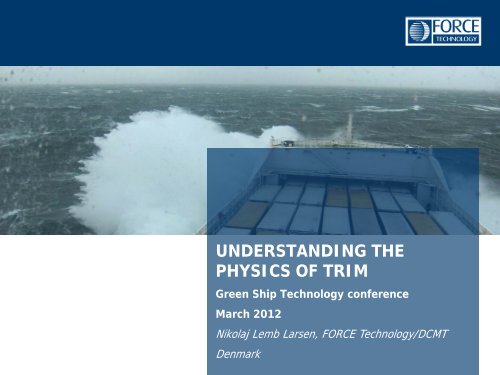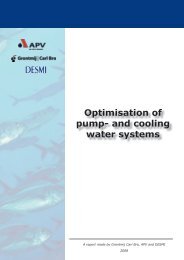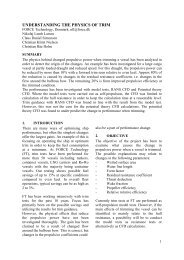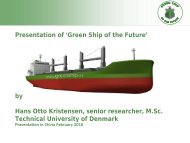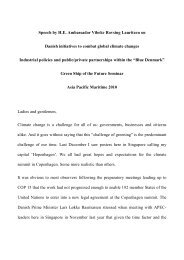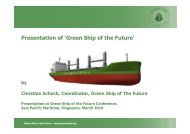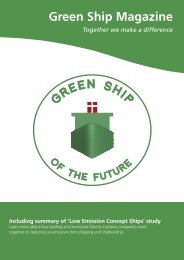UNDERSTANDING THE PHYSICS OF TRIM
Presentation: Understanding the physics of trim - FORCE Technology
Presentation: Understanding the physics of trim - FORCE Technology
You also want an ePaper? Increase the reach of your titles
YUMPU automatically turns print PDFs into web optimized ePapers that Google loves.
<strong>UNDERSTANDING</strong> <strong>THE</strong><strong>PHYSICS</strong> <strong>OF</strong> <strong>TRIM</strong>Green Ship Technology conferenceMarch 2012Nikolaj Lemb Larsen, FORCE Technology/DCMTDenmark
Trimming a vesselFORCE Technology have performed more than 50 model trim tests within the last10 years:• Savings up to 15% at specific conditions• Overall saving up to 2 to 3%• Focus on trim guidanceIn the following focus will be on the effects that cause the change in power.Definition:Trim = T A−T FPositive trim to the aft.
Change in propulsive power due to trimThe change in propulsive power may relate tofollowing parameters:• Wetted surface area• Water line length• Form factor• Residual resistance coefficient• Thrust deduction• Wake fraction• Propeller efficiency• Relative rotative efficiencyResult of the study may be a change in approach:Now -> Self-propulsion model testFuture -> Resistance model test or CFD?
Reference vessel – Large cargo vessel• Represents most large car-carriers,Ro-Ro vessels, container carriers etc.• Pronounced bulbous bow, slender hull,centre skeg and one propeller• Tested at one partly loaded condition• Trim from -2.5m to 2.0m in steps of0.5m• Tested speeds: Fn=0.128, 0.164 and0.201(Design speed Fn=0.228)• Results presented are for Fn=0.128 andtrim=-2.0, 0.0 and 2.0m only!• Resistance and Self-Propulsion modeltests• Repeated with resistance RANS CFDand potential theory CFD
Trim guidancePropeller power deviation as function of trim,compared to even keel.Fn=0.128Fn=0.164Fn=0.201Trim (m)0-2.50 -2.00 -1.50 -1.00 -0.50 0.00 0.50 1.00 1.50 2.002015105-5Power deviation (%)-10-15Results for Froude number = 0.128 (Red curve)Trim -2.0m 0.0m 2.0mΔP D [%] -11.3% 0.0% 20.7%
Propulsive powerThe propulsive power can be described by thefollowing formula:PSpeed (V) is kept constant.DRT⋅V=ηTIn order to gain from the trim:• Decrease hull resistance (R T )• Increase the total propulsive efficiency (η T )The effects are analysed individually althoughthey might be dependent on each other.
Hull resistanceHull resistance according to ITTC-standards:R= ½ ⋅ ρ ⋅V⋅ S ⋅2TC TChanges relate to either wetted surface area (S) or thetotal resistance coefficient (C T ).C = C + (1 + k)C + CTRForm factor (1+k) and allowance coefficient (C A ) arekept constant.Changes in the total resistance coefficient will then be aresult of:• Changed residual resistance coefficient (C R ) or• Changed frictional resistance coefficient (C A )FA
Wetted surface areaWetted surface area (m 2 )162501623016210Results for Froude number = 0.128Trim -2.0m 0.0m 2.0mS [m 2 ] 16181.4 16223.6 16241.3ΔS [%] -0.3% 0.0% 0.1%ΔP D S [%] -0.3% 0.0% 0.1%16190Trim (m)16170-2.5 -2 -1.5 -1 -0.5 0 0.5 1 1.5 2The wetted surface area changesmainly aft due to “flat” stern region.Changes at the propulsive power areminimum.
Frictional resistance coefficientCalculated accordingly to ITTC-standards.C F0.075( log ( Re)− ) 2102Where Re is the Reynolds number for the flowalong the hull.ReSpeed and kinematic viscosity (v) are constant,but the water line length changes with trim.Results for Froude number = 0.128==V ⋅ L wlνTrim -2.0m 0.0m 2.0mΔL WL [%] -2.5% 0.0% 1.8%Re [-] 1.91E+09 1.95E+09 2.00E+09C F [-] 1.415E-03 1.412E-03 1.407E-03ΔP D Lwl [%] 0.2% 0.0% -0.3%Changes at the propulsive power are minimum.
Residual resistance coefficient (1/3)
Residual resistance coefficient (2/3)
Residual resistance coefficient (3/3)Results for Froude number = 0.128Residual resistance coefficient [-]6.0E-045.0E-044.0E-043.0E-042.0E-041.0E-04Trim (m)0.0E+00-2.5 -2 -1.5 -1 -0.5 0 0.5 1 1.5 2Trim -2.0m 0.0m 2.0mC R [-] 6.80E-05 2.34E-04 5.41E-04ΔC R [%] -70.9% 0.0% 131.7%ΔP D CR [%] -8.8% 0.0% 16.4%Residual resistance coefficient isthe part of the hull resistancemost affected by trim!Approx 80% of the total saving bytrimming is from changes in theresidual resistance coefficient.
Propulsive efficiencyDescribed by three parts:ηT= ηH⋅η0⋅ηRRRelative rotative efficiency (η RR )Propeller efficiency (η 0 )Hull efficiency (η H )The hull efficiency can described by two factors:ηH1− t= 1 − wThrust deduction (t)Wake fraction (w)
Thrust deductionShould be as low as possible in order to gain on the hull efficiency!Function of the propeller thrust (T) and the hull resistance.t=T− RTTThrust deduction0.180.160.14Fn=0.128Fn=0.164Fn=0.201Results for Froude number = 0.128Trim -2.0m 0.0m 2.0mt [-] 0.166 0.145 0.147Δt [%] 14.9% 0.0% 1.7%ΔP D t [%] 2.5% 0.0% 0.3%0.12Trim (m)0.1-2.5 -2 -1.5 -1 -0.5 0 0.5 1 1.5 2
Wake fractionShould be as high as possible in order to gain on the hull efficiency!Function of the vessel speed (V) and propeller inflow velocity (V A ).w =V −VVAAWake fraction0.220.2Fn=0.128Fn=0.164Fn=0.201Results for Froude number = 0.128Trim -2.0m 0.0m 2.0mw [-] 0.209 0.181 0.17Δw [%] 15.5% 0.0% -6.1%ΔP D w [%] -3.5% 0.0% 1.3%0.18Trim (m)0.16-2.5 -2 -1.5 -1 -0.5 0 0.5 1 1.5 2
Propeller efficiencyNon-dimensionalised result of apropeller test i.e. not in the wakefield. Plotted as a function of theadvance ratio (J).J=VAn⋅DPropeller revolutions (n)Propeller diameter (D)10.90.80.70.60.50.40.30.20.10Open Water0 0.2 0.4 0.6 0.8 1Results for Froude number = 0.128Trim -2.0m 0.0m 2.0mJ [-] 0.751 0.752 0.729η 0 [-] 0.638 0.639 0.629Δη 0 [-] -0.1% 0.0% -1.5%ΔP D η0 [%] 0.1% 0.0% 1.5%KT10KQηoJ
Relative rotative efficiencyFunction of the torque in openwater (Q ow ) and torque behindship (Q ship ) :ηRRQ=QowshipRelative rotative efficiency1.011.000.99Fn=0.128Fn=0.164Fn=0.201The moment measured on theship/model differs from themoment in open water due tonon-uniform flow and the level ofturbulence.Trim (m)0.98-2.5 -2 -1.5 -1 -0.5 0 0.5 1 1.5 2Results for Froude number = 0.128Trim -2.0m 0.0m 2.0mη RR [-] 1.005 0.988 0.982Δη RR [-] 1.7% 0.0% -0.6%ΔP D ηRR [%] -1.7% 0.0% 0.6%
Origin of change in propulsive powerFn=0.128From hull resistangeFrom propulsive efficiencyTotal changeTrim -2.0m 0.0m 2.0mΔP D S [%] -0.3% 0.0% 0.1%ΔP D Lwl [%] 0.2% 0.0% -0.3%ΔP D CR [%] -8.8% 0.0% 16.4%ΔP D RT [%] -8.9% 0.0% 16.2%Trim -2.0m 0.0m 2.0mΔP D t [%] 2.5% 0.0% 0.3%ΔP D w [%] -3.5% 0.0% 1.3%ΔP D η0 [%] 0.1% 0.0% 1.5%ΔP D ηRR [%] -1.7% 0.0% 0.6%ΔP D ηT [%] -2.7% 0.0% 3.7%Trim -2.0m 0.0m 2.0mΔP D RT [%] -8.9% 0.0% 16.2%ΔP D ηT [%] -2.7% 0.0% 3.7%ΔP D [%] -11.5% 0.0% 19.9%Ref [%] -11.3% 0.0% 20.7%Diff [%] -0.3% 0.0% -0.7%
Alternative to self-propulsion modeltestsTrim guidance from RANSCFD and model tests arearound the same.On resistance based resultspropeller effects naturally notvisible!Limited resistance variationfor potential theory CFD. Novariation at all for -1.0m trim.1.5 and 2.0m trim notcalculated due toconvergence problems.Possible savings, Fn=0.128ΔRT, RANS CDFΔRT, Model testΔRT, Potential theory CFDΔPD, Model test20%15%10%5%0%-2.5 -2 -1.5 -1 -0.5 0 0.5 1 1.5 2-5%-10%-15%Trim (m)ΔR T = based on resistance resultsΔP D = based on propulsion results
ConclusionsAround 80% of the change in propulsive power origins in changedresidual resistance coefficient. Primarily from changed flow around thebulbous bowRemaining 20% are from changes in the propulsive coefficients.Trim guidance from resistance model tests or alternatively RANS CFDcan give a reasonable result. Especially if it is combined withexperience from self-propulsion tests.The potential theory CFD was found to under predict the change inperformance when trimming.
Thank you for your attentionNikolaj Lemb Larsen, nll@force.dkFORCE Technology, Denmark


